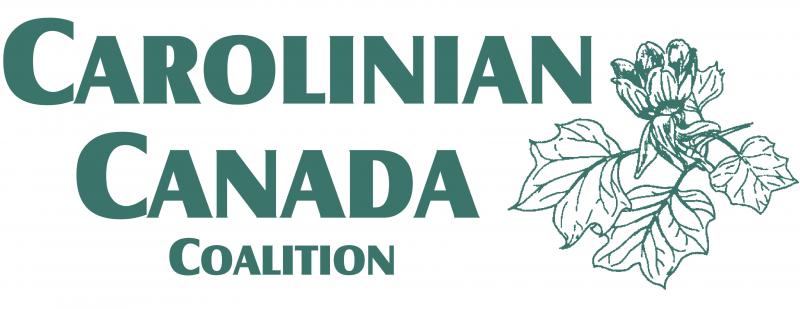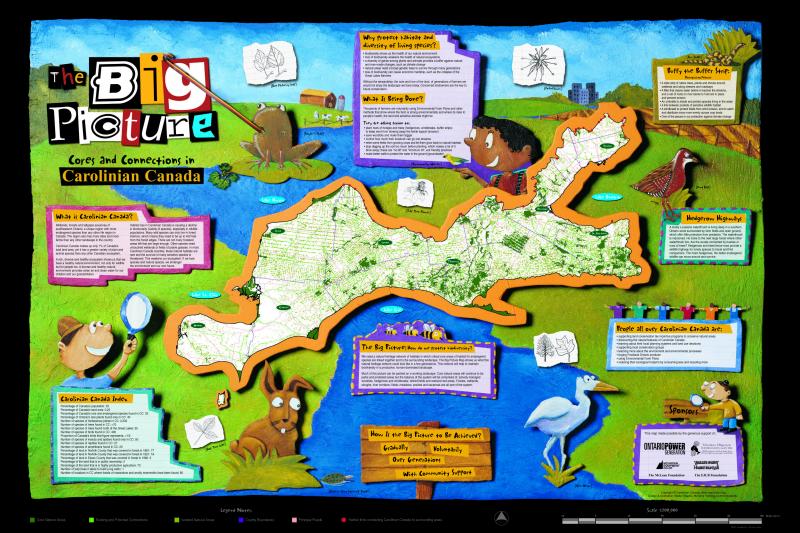| 1984 |
The Carolinian Canada Program is established
In 1984, the Carolinian Canada Program was established as a Steering Committee with 3 government and 3 NGO members: Nature Conservancy of Canada, Wildlife Habitat Canada, the World Wildlife Fund, the Ministry of Natural Resources, the Ministry of Citizenship and Culture, and the Ontario Heritage Foundation. These members recognized that there were critical unprotected natural areas in the Carolinian Life Zone and wanted to work together to protect them.
The steering committee approach adopted by Carolinian Canada introduced a novel and constructive process for setting protection priorities for the Carolinian region.
| 1985 |
Critical Unprotected Natural Areas in the Carolinian Life Zone of Canada
By Paul Eagles and Tom Beechey
38 sites were identified as critical unprotected natural areas in a study by the identification sub-committee of Carolinian Canada. Now known as Carolinian Canada Signature Sites, many of these sites are now owned by conservation organizations and can be visited today, and provide excellent places to explore Carolinian ecosystems.
Click here to learn more about the Carolinian Canada Signature Sites on our old webpage
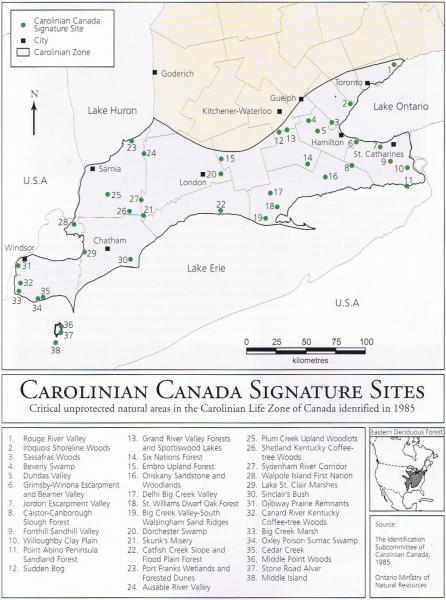
| 1987 |
Land Acquisition and Stewardship Program
From 1984-1994, Carolinian Canada funded land acquisition and stewardship projects directed at conserving the 38 critical unprotected areas across the region. These programs resulted in private landowners agreeing to conserve over 15,000 acres and acquisition of 2,000 acres by conservation groups. Public education and scientific studies were also undertaken.
| 1990 |
Conserving Carolinian Canada: Conservation Biology in the Deciduous Forest Region
By G. Allen, Paul Eagles and S. Price
| 1994 |
Plants of Carolinian Canada
By Larry Lamb and Gail Rhynard, illustrations by Judie Shore

This beautifully illustrated book was created to familiarize readers with 40 of the more interesting representative herbaceous (non-woody) plant species in the Carolinian zone. Read anecdotes about Nodding Onion, Yamroot and Prickly Pear Cactus (among others), their traditional uses and where their scientific names come from.
| 1996-97 |
The Conservation Strategy for Carolinian Canada
After 12 years of program activities that focused on the 38 critical natural areas in Carolinian Canada, the Carolinian Canada Steering Committee commissioned the development of a Conservation Strategy for Carolinian Canada. With the Signature Sites work well underway, the Steering Committee recognized a need for a program that was more community-oriented; a program that addressed the entire landscape rather than only individual sites. The Conservation Strategy involved a number of parts:
- An Issues and Options report, which examined trends in land use and natural features, the adequacy of existing programs, issues related to conservation biodiversity and possible options for the future.
- Vision and Priorities workshop, which invited a diverse group of stakeholders to suggest priorities for conservation efforts in Carolinian Canada.
- Objectives and Actions plan, where a multi-stakeholder group was asked to refine the work done in the Vision and Priorities workshop and develop priority goals and objectives.
The five priority goals identified in the Conservation Strategy for Carolinian Canada (1997) guided future Coalition activities.
- Education Goal: Achieve broad awareness of the importance of ecosystems, communities and endangered species in the Carolinian region by the general public and particularly by landowners, and gain their support for measures to protect biodiversity
- Community Action Goal: Achieve broad community level action in support of biodiversity and conservation of natural communities and endangered species throughout the Carolinian region, including the urban landscape
- Forest Goal: Achieve no further loss of native forest cover and a substantial increase including an appropriate proportion of interior forest.
- Stream/Wetland Goal: Achieve no further loss and a substantial increase in steam water quality and wetland quantity.
- Prairie/Savannah Goal: Protect all significant remaining prairie/savannah habitats and restore the full range of native prairie/savannah communities in appropriate locations.
Carolinian Canada Management Committee
Carolinian Canada Coalition is managed by an informal governing body made up of representatives from a wide range of sectors, chaired by Paul Smith. The office is housed at the Ministry of Natural Resources in London, Ontario. Finances are managed by the Lambton Wildlife Inc.
| 1998 |
Caring for Your Land: A Stewardship Handbook for Carolinian Landowners
By Stewart Hilts and Peter Mitchell, drawings by Ann-Ida Beck
| 1999 |
Carolinian Canada’s handed out its first Conservation Awards to Paul Prevett and the Canadian Chestnut Council
| 2000 |
The Big Picture
In 2000 Carolinian Canada began to develop the Big Picture to address the needs for a landscape approach to natural heritage protection. The best available natural heritage data for the region was combined, and then subjected to an analysis to project a network of core areas and connecting links. The resulting vision of a sustainable natural heritage network provides a framework for restoration and recovery efforts.
The Big Picture maps out a regional natural heritage system with 110 core natural areas connected by landscape scale corridors, using the best available science and advanced mapping techniques.
| 2002 |
Practical Options for the Greening of Carolinian Canada
By Rob Reid and the Carolinian Canada Coalition
This paper examines a broad spectrum of possible new tools, drawing from programs currently in place, to help achieve the Big Picture vision in Carolinian Canada.
- Sharing the Vision
- Strengthening Incentives for Conservation
- Informing and Educating for Conservation and Restoration
- Funding Land Securement and Restoration
- The Role of Land Use Planning and Management
Swamp Cottonwood discovered in Carolinian Canada
Swamp Cottonwood a native tree never seen before in Canada was recently discovered at Bickford Oak Woods, on the St Clair River south of Sarnia in Lambton County. The stand of over 60 Swamp Cottonwood (Populus heterophylla) was found during a site inventory in November 2002, after the Nature Conservancy of Canada (NCC) secured the site earlier in that year.
“We are very excited about this discovery,” said John Riley Director of Science and Stewardship for NCC. “Ecologists in Canada are still learning about the basics of our biodiversity and now we can add another species to our country’s biological inventory list. This is a great example of why it’s important for us to protect the natural heritage we have left.”
This is just one example of our partners work to prioritize conservation of Carolinian Canada sites and how new species are still being discovered.
Species at Risk Act established
| 2003 |
Carolinian Canada Coalition moved into Grosvenor Lodge
| 2004 |
Carolinian Canada initiated the Carolinian Woodland Recovery Strategy
Species @ Risk in Carolinian Canada and How to Help - handbook and set of 2 posters
By Michelle Kanter, Dave Martin, Veronique LeHouck, and Jane Bowles
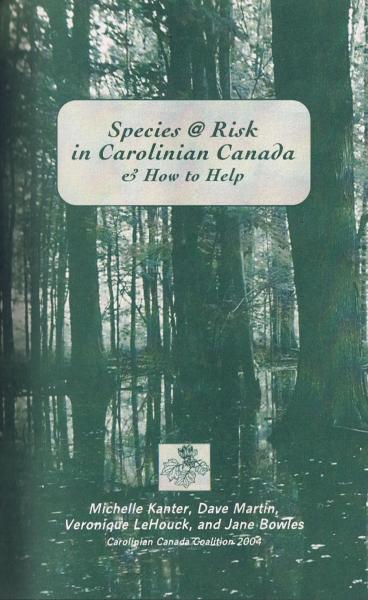
| 2005 |
Carolinian Canada Signature Sites: A Guide to 38 Special Natural Areas in Ontario’s Deep South and Heritage Plaques Celebrating Community Conservation
By Lorraine Johnson
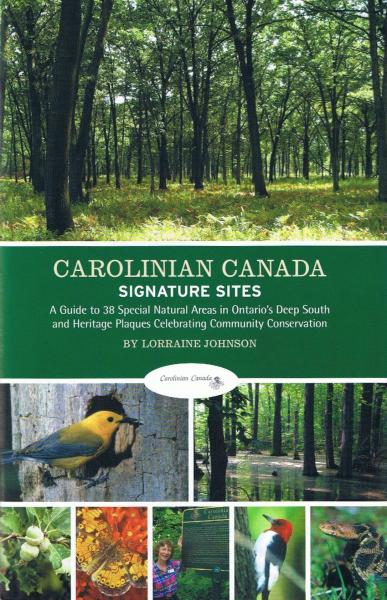
"As a part of Carolinian Canada's early efforts, a subcommittee of scientists and stakeholders reviewed inventories of all the remaining natural areas in the Carolinian life zone and identified 38 key sites as being of critical importance -- the best representatives of particular community and ecosystem types across the zone that were, at that time, in 1984, unprotected" (Johnson, 6, 2005). This book provides a guide to those 38 Carolinian Canada Signature Sites
Initiated the Ecosystem Recovery Program
| 2006 |
Incorporation
Carolinian Canada Coalition became an incorporated body in October 2006. This gave Carolinian Canada financial recognition as a conservation organization with the right to hold its own funds. Prior to this, Lambton Wildlife Fund managed the finances of Carolinian Canada.
| 2007 |
The Natural Treasures of Carolinian Canada
By the Carolinian Canada Coalition and Lorraine Johnson
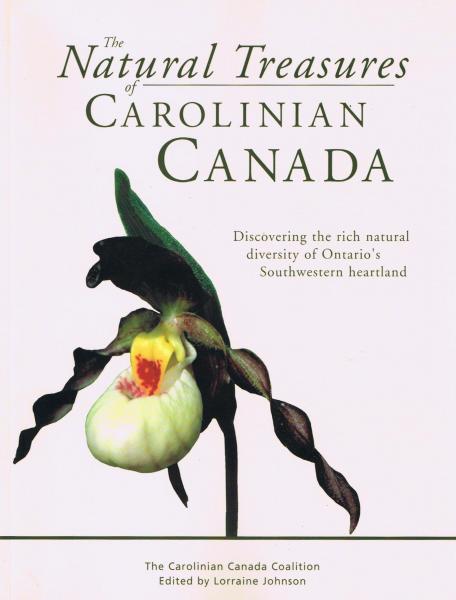
First Election, installed a slate of 13 directors
Initiated the Caring for Nature Factsheets
| 2008 |
Began Conservation Action Planning in Carolinian Canada
Carolinian Canada Coalition began Conservation Action Planning for biodiversity hotspots in Carolinian Canada. Conservation Action Plans were initiated for three hotspots: Essex Forests and Wetlands; Ausable River – Kettle Point to Pinery; and Upper Thames River.
Launched the Carolinian Student Intern Program with the University of Waterloo.
| 2009 |
Launched the Coastal Zone Program and laid the groundwork for what would eventually be the Erie Coastal Stewardship EcoTrail.
Essex Forests and Wetlands Conservation Action Plan and Ausable River - Kettle Point to Pinery Conservation Action Plan completed.
| 2010 |
Hamilton - Burlington 7E-3 Conservation Action Plan, Short Hills Conservation Action Plan and Niagara River Corridor Conservation Action Plan completed.
| 2012 |
Elgin Greenway Conservation Action Plan completed.
| 2014 |
Grand River Conservation Action Plan and Sydenham River Conservation Action Plan completed.
We celebrate our 30th anniversary!
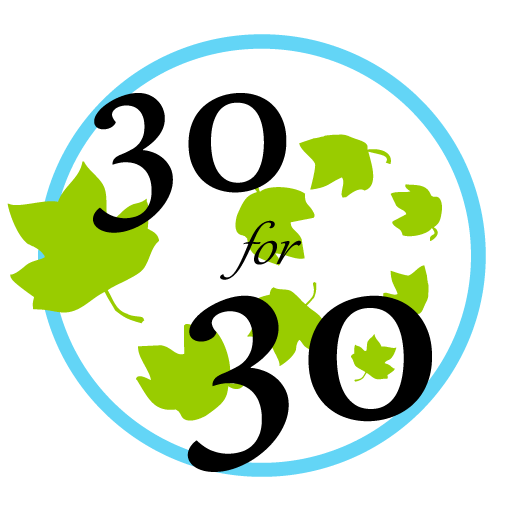

Articles of Transition replace Letters Patent
New By-Law 1 approved, new slate of First Directors and application required to transition to new Not-For-Profit Act

